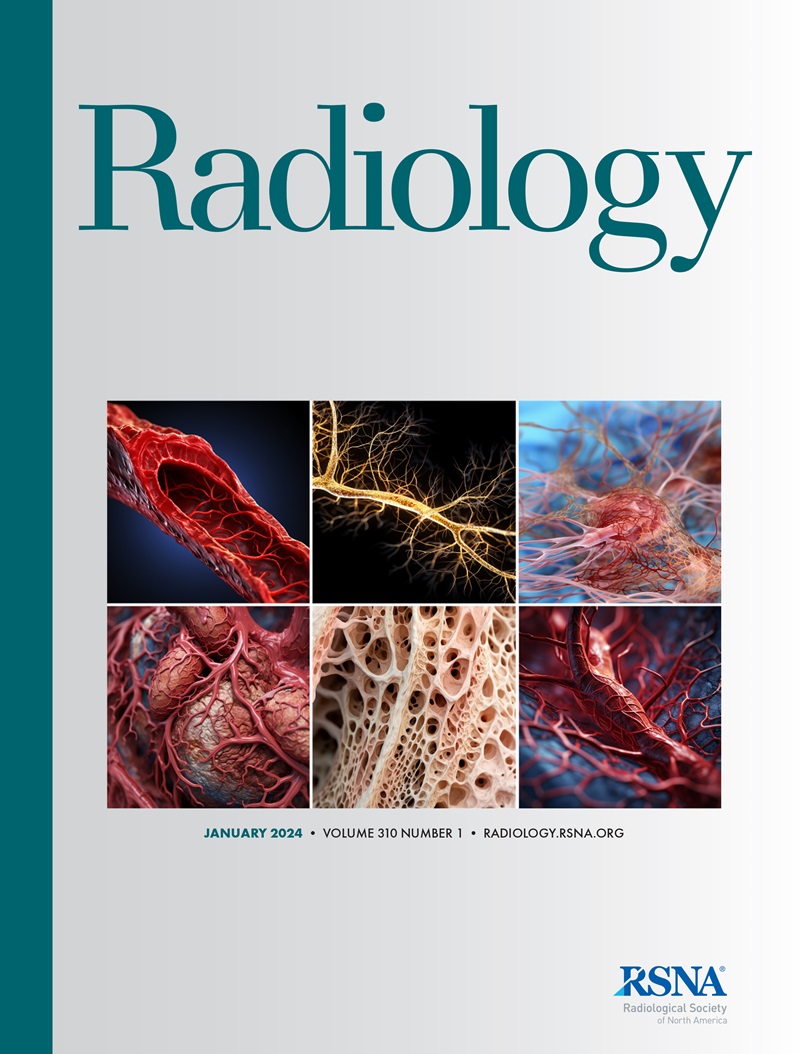Toulsie Ramtohul, Victoire Lepagney, Claire Bonneau, Maxime Jin, Emmanuelle Menet, Juliette Sauge, Enora Laas, Emanuela Romano, Diana Bello-Roufai, Fatima Mechta-Grigoriou, Anne Vincent Salomon, François-Clément Bidard, Adriana Langer, Caroline Malhaire, Luc Cabel, Hervé J Brisse, Anne Tardivon
求助PDF
{"title":"利用基于治疗前灌注磁共振成像的瘤内异质性预测三阴性乳腺癌对新辅助化疗免疫疗法的病理反应","authors":"Toulsie Ramtohul, Victoire Lepagney, Claire Bonneau, Maxime Jin, Emmanuelle Menet, Juliette Sauge, Enora Laas, Emanuela Romano, Diana Bello-Roufai, Fatima Mechta-Grigoriou, Anne Vincent Salomon, François-Clément Bidard, Adriana Langer, Caroline Malhaire, Luc Cabel, Hervé J Brisse, Anne Tardivon","doi":"10.1148/radiol.240575","DOIUrl":null,"url":null,"abstract":"<p><p>Background Neoadjuvant chemoimmunotherapy (NACI) has significantly increased the rate of pathologic complete response (pCR) in patients with early-stage triple-negative breast cancer (TNBC), although predictors of response to this regimen have not been identified. Purpose To investigate pretreatment perfusion MRI-based radiomics as a predictive marker for pCR in patients with TNBC undergoing NACI. Materials and Methods This prospective study enrolled women with early-stage TNBC who underwent NACI at two different centers from August 2021 to July 2023. Pretreatment dynamic contrast-enhanced MRI scans obtained using scanners from multiple vendors were analyzed using the Tofts model to segment tumors and analyze pharmacokinetic parameters. Radiomics features were extracted from the rate constant for contrast agent plasma-to-interstitial transfer (or <i>K</i><sup>trans</sup>), volume fraction of extravascular and extracellular space (<i>V</i><sub>e</sub>), and maximum contrast agent uptake rate (Slope<sub>max</sub>) maps and analyzed using unsupervised correlation and least absolute shrinkage and selector operator, or LASSO, to develop a radiomics score. Score effectiveness was assessed using the area under the receiver operating characteristic curve (AUC), and multivariable logistic regression was used to develop a multimodal nomogram for enhanced prediction. The discrimination, calibration, and clinical utility of the nomogram were evaluated in an external test set. Results The training set included 112 female participants from center 1 (mean age, 52 years ± 11 [SD]), and the external test set included 83 female participants from center 2 (mean age, 47 years ± 11). The radiomics score demonstrated an AUC of 0.80 (95% CI: 0.70, 0.89) for predicting pCR. A nomogram incorporating the radiomics score, grade, and Ki-67 yielded an AUC of 0.86 (95% CI: 0.78, 0.94) in the test set. Associations were found between higher radiomics score (>0.25) and tumor size (<i>P</i> < .001), washout enhancement (<i>P</i> = .01), androgen receptor expression (<i>P</i> = .009), and programmed death ligand 1 expression (<i>P</i> = .01), demonstrating a correlation with tumor immune environment in participants with TNBC. Conclusion A radiomics score derived from pharmacokinetic parameters at pretreatment dynamic contrast-enhanced MRI exhibited good performance for predicting pCR in participants with TNBC undergoing NACI, and could potentially be used to enhance clinical decision making. © RSNA, 2024 <i>Supplemental material is available for this article.</i> See also the editorial by Rauch in this issue.</p>","PeriodicalId":20896,"journal":{"name":"Radiology","volume":"312 3","pages":"e240575"},"PeriodicalIF":12.1000,"publicationDate":"2024-09-01","publicationTypes":"Journal Article","fieldsOfStudy":null,"isOpenAccess":false,"openAccessPdf":"","citationCount":"0","resultStr":"{\"title\":\"Use of Pretreatment Perfusion MRI-based Intratumoral Heterogeneity to Predict Pathologic Response of Triple-Negative Breast Cancer to Neoadjuvant Chemoimmunotherapy.\",\"authors\":\"Toulsie Ramtohul, Victoire Lepagney, Claire Bonneau, Maxime Jin, Emmanuelle Menet, Juliette Sauge, Enora Laas, Emanuela Romano, Diana Bello-Roufai, Fatima Mechta-Grigoriou, Anne Vincent Salomon, François-Clément Bidard, Adriana Langer, Caroline Malhaire, Luc Cabel, Hervé J Brisse, Anne Tardivon\",\"doi\":\"10.1148/radiol.240575\",\"DOIUrl\":null,\"url\":null,\"abstract\":\"<p><p>Background Neoadjuvant chemoimmunotherapy (NACI) has significantly increased the rate of pathologic complete response (pCR) in patients with early-stage triple-negative breast cancer (TNBC), although predictors of response to this regimen have not been identified. Purpose To investigate pretreatment perfusion MRI-based radiomics as a predictive marker for pCR in patients with TNBC undergoing NACI. Materials and Methods This prospective study enrolled women with early-stage TNBC who underwent NACI at two different centers from August 2021 to July 2023. Pretreatment dynamic contrast-enhanced MRI scans obtained using scanners from multiple vendors were analyzed using the Tofts model to segment tumors and analyze pharmacokinetic parameters. Radiomics features were extracted from the rate constant for contrast agent plasma-to-interstitial transfer (or <i>K</i><sup>trans</sup>), volume fraction of extravascular and extracellular space (<i>V</i><sub>e</sub>), and maximum contrast agent uptake rate (Slope<sub>max</sub>) maps and analyzed using unsupervised correlation and least absolute shrinkage and selector operator, or LASSO, to develop a radiomics score. Score effectiveness was assessed using the area under the receiver operating characteristic curve (AUC), and multivariable logistic regression was used to develop a multimodal nomogram for enhanced prediction. The discrimination, calibration, and clinical utility of the nomogram were evaluated in an external test set. Results The training set included 112 female participants from center 1 (mean age, 52 years ± 11 [SD]), and the external test set included 83 female participants from center 2 (mean age, 47 years ± 11). The radiomics score demonstrated an AUC of 0.80 (95% CI: 0.70, 0.89) for predicting pCR. A nomogram incorporating the radiomics score, grade, and Ki-67 yielded an AUC of 0.86 (95% CI: 0.78, 0.94) in the test set. Associations were found between higher radiomics score (>0.25) and tumor size (<i>P</i> < .001), washout enhancement (<i>P</i> = .01), androgen receptor expression (<i>P</i> = .009), and programmed death ligand 1 expression (<i>P</i> = .01), demonstrating a correlation with tumor immune environment in participants with TNBC. Conclusion A radiomics score derived from pharmacokinetic parameters at pretreatment dynamic contrast-enhanced MRI exhibited good performance for predicting pCR in participants with TNBC undergoing NACI, and could potentially be used to enhance clinical decision making. © RSNA, 2024 <i>Supplemental material is available for this article.</i> See also the editorial by Rauch in this issue.</p>\",\"PeriodicalId\":20896,\"journal\":{\"name\":\"Radiology\",\"volume\":\"312 3\",\"pages\":\"e240575\"},\"PeriodicalIF\":12.1000,\"publicationDate\":\"2024-09-01\",\"publicationTypes\":\"Journal Article\",\"fieldsOfStudy\":null,\"isOpenAccess\":false,\"openAccessPdf\":\"\",\"citationCount\":\"0\",\"resultStr\":null,\"platform\":\"Semanticscholar\",\"paperid\":null,\"PeriodicalName\":\"Radiology\",\"FirstCategoryId\":\"3\",\"ListUrlMain\":\"https://doi.org/10.1148/radiol.240575\",\"RegionNum\":1,\"RegionCategory\":\"医学\",\"ArticlePicture\":[],\"TitleCN\":null,\"AbstractTextCN\":null,\"PMCID\":null,\"EPubDate\":\"\",\"PubModel\":\"\",\"JCR\":\"Q1\",\"JCRName\":\"RADIOLOGY, NUCLEAR MEDICINE & MEDICAL IMAGING\",\"Score\":null,\"Total\":0}","platform":"Semanticscholar","paperid":null,"PeriodicalName":"Radiology","FirstCategoryId":"3","ListUrlMain":"https://doi.org/10.1148/radiol.240575","RegionNum":1,"RegionCategory":"医学","ArticlePicture":[],"TitleCN":null,"AbstractTextCN":null,"PMCID":null,"EPubDate":"","PubModel":"","JCR":"Q1","JCRName":"RADIOLOGY, NUCLEAR MEDICINE & MEDICAL IMAGING","Score":null,"Total":0}
引用次数: 0
引用
批量引用

 求助内容:
求助内容: 应助结果提醒方式:
应助结果提醒方式:


